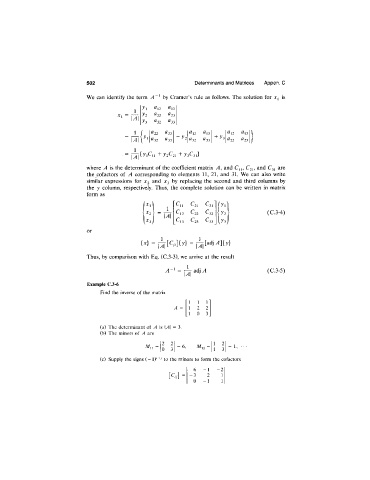Page 515 - Thomson, William Tyrrell-Theory of Vibration with Applications-Taylor _ Francis (2010)
P. 515
502 Determinants and Matrices Appen. C
W e can identify the term by Cram er’s rule as follows. The solution for is
^12 ^13
J _
JCi = >”2 ^22 ^23
1^1
^3 ^32 ^33
^22 ^23
/v yi + ^3
^32 ^33 *33 *'22 *23
■ ^3^2^21 3^3^ 31}
\A\
where A is the determ inant of the coefficient m atrix A , and C ^ , C 21, and C 31 are
the cofactors of A corresponding to elements 11, 21, and 31. W e can also write
sim ilar expressions for JC 2 and by replacing the second and third colum ns by
the y colum n, respectively. Thus, the complete solution can be written in m atrix
form as
C u ^21 ^31
h i
C ,2 ^22 C 32 (C .3-4 )
\A\
C,3 ^23 ^33 i> '3j
or
\ X \ = r4 r[C ^ ,]{y } = r ^ [ a d j/l] { y }
\ A \ i M l'
Thus, by com parison with Eq. (C.3-3), we arrive at the result
1
(C .3-5)
Example C.3-6
Find the inverse of the matrix
1 1 1
A = 1 2 2
1 0 3
(a) The determinant of A is |y4| = 3.
(b) The minors of A are
2 2
0 3 = 6, M,, = = 1,
(c) Supply the signs (-1)''^^ to the minors to form the cofactors
6 -1 - 2
C, = -3 2 1
0 -1 1

